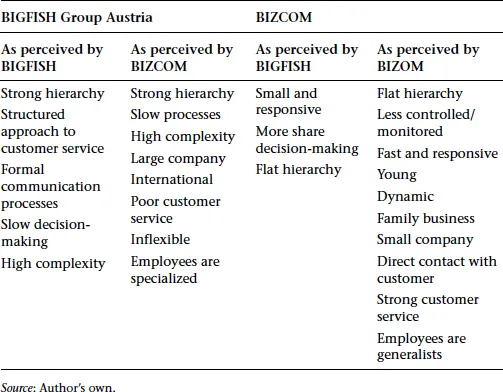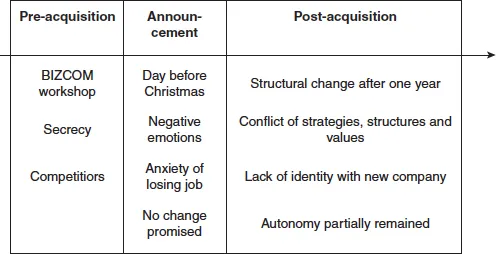![]()
1
Timing of Communication in Organizational Culture Change Processes: The Case of a Domestic Acquisition
Daniel Dauber
Editor’s introduction
This case study meticulously charts a commercial acquisition, with the objective of demonstrating the importance of synchronizing organizational communication with organizational change, if both parties are not to suffer traumatic culture shocks. Dauber clearly illustrates the need to find common ground before implementing major decisions, in order to create synergies and harmonize operations that will ease the transition from two companies into one.
His study reveals how open communication is particularly necessary if there are major cultural differences between the relevant firms, otherwise employee commitment, motivation and efficiency will suffer. The more dissimilar the culture, the more the likelihood of misinterpretation, that is, noise.1 Communication, therefore, is a complex process of linking up or sharing perceptions: this requires understanding, and trust promotes it. This is not to say that trust is essential. All over the world, every day, business and government transactions take place between people who wouldn’t trust each other further than they could throw them.2 Nevertheless, as Dauber demonstrates, collaboration and alliances do depend to some degree on trust developed between parties over time.
Schwartz’s research3 identified hierarchy versus egalitarianism (authoritarian leadership vs democratic decisions) as a major dimension of individual work values; and Dauber’s study supports this. He found BIGFISH to own a strong and formal organizational hierarchy, whereas that of BIZCOM was flat and friendly: and these cultural differences resulted in unnecessary conflict because they were poorly handled by senior management.
These are some of the ways in which Dauber follows and analyzes the process of the BIGFISH/BIZCOM acquisition; and he offers suggestions for organizational communication, and for the timing of such communication, that might have made for a smoother ride.
Abstract:
The presented case study sheds light on timing and communication dilemmas caused by organizational change and organizational culture differences. Since the case study is of a national acquisition, factors such as organizational culture can be analysed more systematically and reliably. It is particularly suitable for lecturers and students who wish to analyse intercultural communicative challenges that individuals and groups face in workplace contexts where organizational and sub-organizational cultures differ substantially. By drawing on 19 narrative interviews with members of the acquiring and target company, a systematic analysis of communication processes was undertaken using the configuration model of organizational culture.
Keywords: acquisition, communication, configuration model of organizational culture, cultural differences, M&A.
Introduction
Setting the scene for the case of a domestic acquisition
Mergers and acquisitions (M&As) are by far the most popular market entry strategy, and yet their success rate is considered to be stunningly low.4 Prior research has pinpointed the relevance of proper post-M&A integration management and intercultural communication as decisive factors to determine whether expected synergies will ultimately unfold and pre-defined goals can be achieved.5
While several studies have focused on cross-border M&As, less is known about domestic acquisitions. Although these do not “suffer” from language barriers, they nevertheless suffer from what could be considered as the “single-layered acculturation shock” and the unexpected cultural differences between organizations experienced by people exposed to changes in an acquisition.
This case study sheds light on organizational culture differences and their interaction and goes beyond communication issues resulting from differences in languages. In particular, emphasis is put on the concept of “timing” as well as dilemmas of timing in communication and how it affects the change process and those people involved. By drawing on 19 narrative interviews with members of the acquiring and target company, evidence from a real acquisition will be used to highlight issues emerging from organizational culture differences, rather than national culture differences.
In a first step, the background of both organizations involved will be outlined and key differences that reflect their organizations’ culture, including values, strategies, structures, and ways of doing business, will be explored. In a second step, the experiences in the first year after the acquisition are critically reviewed, and two common communication issues related to timing of communication will be showcased and analysed in greater detail. This chapter closes with an analysis of the situation using the configuration model of organizational culture6 as an analytical frame of reference.
Case presentation
The acquirer: BIGFISH Global Austria
BIGFISH Global Austria is the Austrian subsidiary of an American communication technology company and counts as one of the top market players in Austria. Their success is largely based on their technology advantage that allowed them to offer their services on a reliable basis to thousands of customers. With a primary focus on business-to-customer (B2C) business, their entire philosophy and strategy are geared towards mass production and therefore a high level of standardization.
Another major reason for their success lies in the independent service delivery infrastructure that they built over the past years. While other competitors were forced to pay third companies to deliver services to their customers, BIGFISH Global Austria decided to build their own infrastructure. This required substantial investment over several years, but offered (1) independence from third-party organizations, (2) total control over distribution channels, (3) technological innovations to provide faster and better communication services and (4) lower prices for customers in the long run.
BIGFISH Global Austria’s strategy allowed them to compete with the market leader at that time, and it can be considered the foundation for their continuing success.
However, more recently, BIGFISH Global Austria recognized that if they want to grow further and stay competitive, they need to expand. While profitable, the current infrastructure and technology limited the company’s reach to a certain capacity of customers. Further expansion using their traditional approach, that is, building more infrastructure themselves, would have been too costly.
Apart from that, a new, small and innovative organization, BIZCOM, shook up the market and developed a new technology that promised better quality at the same price and was not so dependent on such infrastructures. Soon BIGFISH Global Austria realized that acquiring this new technology would not only allow them to further grow their customer base, but also add business customers to their clientele, which constituted the core business of BIZCOM. The idea to undergo an acquisition was born.
The target: BIZCOM
BIZCOM started as a small company, founded by two engineers who had the brilliant idea for a new communication technology that was very well received by companies, which later on became their core business. As the business grew, so did the company, and soon BIZCOM became one of the most relied-on communication solutions for organizations in Austria. Their strong business-to-business (B2B) operations shaped the organization’s future path and organizational culture.
The rapid success in the B2B segment triggered the idea to expand into the B2C segment, using their much more advanced technology, compared to the competition, such as the one used by BIGFISH Global Austria. Therefore, it was less surprising to see that BIZCOM started to gain more and more ground in the B2C business and was mainly perceived as the new positive driving force in the industry, that offered new technology at a fair price. This was also reflected in their main slogan “We are the GOOD ones!,” clearly separating themselves from the competition.
New employees that joined the company did so because they appreciated the small, family-like atmosphere allowing for maximum creative freedom and not being overburdened with administrative structures. This positive spirit certainly added to the success of the company, its quality of products and drive for innovation.
Despite this positive trend, the two owners realized that the initial vision of creating technology started to become less of a major task for them. Instead, they were confronted with an organically growing organization that required pro-active management of staff and, in general, made it necessary to restructure the organization. When BIGFISH Global Austria offered to buy the company and its technology, the two owners considered this a unique opportunity to hand over a healthy business that had started to become too big for them. When the offer was made, the two owners gladly accepted.
Communicative context: organizational cultures, philosophies, structures and ways of doing business
In view of the above, it becomes apparent that the differences between both organizations are manifold. In the course of the interviews, several differences between the organizations were mentioned that seemed to have had a considerable bearing on the efficiency of communication after the acquisition. Table 1.1 highlights these differences as perceived by employees of BIGFISH Group Austria and BIZCOM.
Table 1.1 Operational differences between BIGFISH Group Austria and BIZCOM
Two of the interviewees summarized the differences and the associated problems as follows:
The first year of the acquisition
The following sections outline the takeover before and after the deal was signed. Apart from that, the day the acquisition was announced and the contract had been signed will be illustrated since it had a considerable impact on the entire narrative of this case. Figure 1.1 summarizes the events in chronological order, including the reported issues in terms of communication.
Figure 1.1 Chronological order of events that took place in the acquisition
Source: Author.
Pre-announcement: rumours and false information
The acquisition was officially signed and announced on December 23. As usual for every acquisition, there was only a small group of people who knew about the acquisition in advance and the members were mainly responsible for the due diligence, that is, the evaluation of the target company prior to the takeover. This was true for both sides, BIGFISH Gr...


